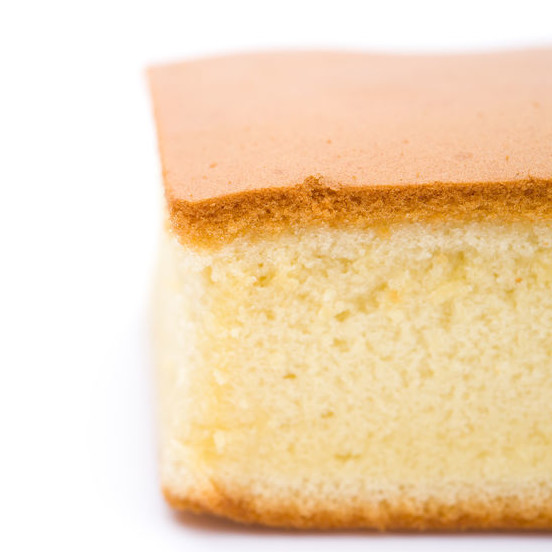Origin
The earliest recorded mention of sponge cakes was from a Renaissance age Italian baked product. Italian cooks baked “biscuits,” which spread through Italy, England and France. However, it was not until 1615 when the first sponge cake recipe was recorded by the English poet and author Gervase Markham. Still, the cake was much more like a cookie—thin and crispy.
Sponge cakes became well-recognized when bakers started using beaten eggs as a leavening agent in the mid 18th century. Often the batter was poured into elaborate molds, but also into two tin hoops—the precursor to modern cake pans.
How it is made
To achieve its characteristic light texture, sponge cake uses whipped eggs. Similar to angel food cake, it relies on the leavening action of air whipped into and trapped by egg protein. The increase in volume is achieved by trapped air and water vapor that expand during baking.
Baking powder and/or baking soda are sometimes added to sponge cake formulations to provide additional rise through the production of CO2. Such cakes typically have a high volume and feature a light, fluffy texture.
Base formulation
| Ingredient | Baker’s % (based on flour weight) |
| Cake flour (short patent cake flour)* | 100.0 |
| Granulated sugar | 80.0–175.0 |
| Whole eggs + egg yolks | 50.0–175.0 |
| Salt | 2.0–3.0 |
| Water / liquid milk (optional) | Varies depending on target specific gravity |
| Milk solids (optional) | 0.0–6.0 |
| Baking powder (optional) | 0.0–6.0 |
| Melted butter / shortening | 0.0–10.0 |
| Corn syrup | 0.0–20.0 |
| Emulsifier | Varies |
*Can also be replaced by pastry flour with addition of starch
Adjustments to the base formulation should be made for various product specifications and target markets. Sugar, water, milk solids, baking powder and other minor ingredients can be added only if proper formula balancing is exercised. In sponge cakes, eggs are structure builders that must be balanced against sugar, which functions as a tenderizer and tends to weaken the crumb structure.
Guidelines for balancing sponge cake formulas:1
- The weight of sugar should equal or exceed that of eggs
- The total weight of liquids, including eggs, should be greater than the weight of sugar
- The weight of flour should be less than that of the sugar or the eggs
- The total weight of the eggs and the flour should exceed the total weight of the sugar and liquids
Processing
- Ingredients scaling.
- Mixing (hot / cold process).
- Depositing.
- Baking. Bake at 360–425°F (182–218°C) to an internal temperature of 204°F (95°C). Hot processed batter should have a shorter baking time. Cold processed batter should be baked longer.
- Deppaning. Depan from oven onto dusted paper pan liners while the cakes are still warm.
- Cooling. Cool product to loaf internal temperature of 95–105°F (35–40°C) before slicing and packaging
- Slicing.
- Packaging or serving.
Application
Hot processing
This mixing process involves heating equal parts of sugar and eggs to 110°F (43°C) before whipping. The heat ensures that sugars are dissolved, and helps the proteins to denature and incorporate air more efficiently. Both whole eggs and egg yolks produce lighter and more stable foams at a faster rate when warm.
Whipping is considered complete when creases begin to form and are slow in closing. For the hot process method, the desired batter temperature is 90–94°F (32–34°C) at a specific gravity of 0.4–0.6.
Cold processing
This process involves whipping eggs that have been refrigerated or at room temperature prior to incorporating the rest of the ingredients. The cold process uses emulsifiers and baking powder to ensure aeration of the foam. Desired batter temperature is 68–72°F (20–22°C) with a specific gravity of 0.6–0.9. The cold process allows for higher tolerance to processing.
References
- Gisslen, W. “Cake Mixing and Baking.” Professional Baking, 7th edition, John Wiley & Sons, Ltd, 2017, pp. 373–413.

